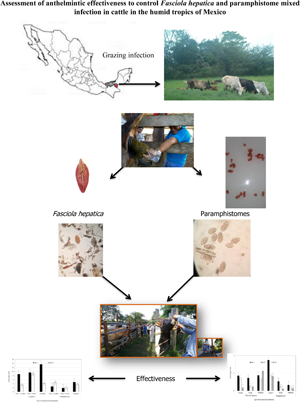Published online by Cambridge University Press: 05 July 2021

The objective of this study was to evaluate the effectiveness of the main anthelmintics used for the control of trematodes in cattle in an endemic area in the humid Mexican tropics. A diagnostic study was carried out in nine cattle farms to determine the prevalence of flukes through faecal examination. Only three farms with more than 20 cows positive to trematodes were chosen to determine the effectiveness of commercial anthelmintics (triclabendazole, TCBZ; ivermectin + closantel, (IVM + CLOS); IVM + clorsulon, (CLORS); nitroxynil, NITROX). The prevalence of Fasciola hepatica was 27.1% and 29.6% of paramphistomes. The faecal egg count of trematodes ranged from 0.0 to 12.2 eggs per gram of faeces. The highest effectiveness against F. hepatica was 96.7%, and 92.7% against paramphistomes. NITROX was the most effective in the control of trematodes, while other products, such as IVM + CLORS and TCBZ obtained values lower than 90%, which puts sustainable trematode control at risk. The presence of trematodes was observed on most farms, although the prevalence per herd was highly variable, which indicates that the trematodes F. hepatica and paramphistomes are endemic to the region and a suitable management programme is suggested to control infections caused by these parasites.